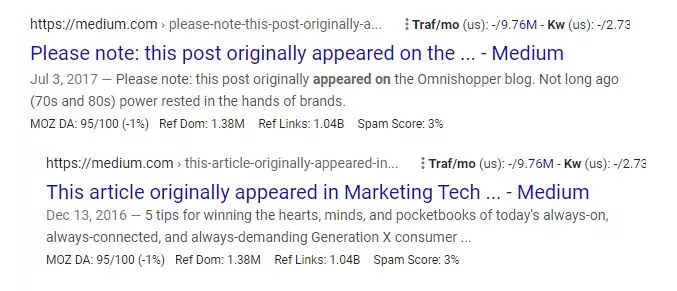Content marketers have a problem: getting traffic amid all that competition out there. But here is one solution that could work for you: content syndication.
First of all, what is content syndication? It’s taking content you’ve already written on your own website and getting others to publish it on their websites.
Now, why would you do that? So you can reach those curated audiences and get more eyes on your content and traffic to your website.
What about the potential roadblocks with content syndication, though? Don’t you have to pay for that? Won’t it count as duplicate content on the Internet?
Don’t worry, because we’re going to explain all about syndicated content in this comprehensive guide, including by covering what it is and how to do it.
So, if you’ve been bringing your content marketing game pretty strong but are still hitting walls with getting traffic, this is for you.
What Is Content Syndication?
First, let’s cover exactly what content syndication is, and what it isn’t.
Just as it sounds, content syndication is the republishing of your existing content on other sources, whether those are online newspapers, magazines, journals, or any other kind of periodical.
You can syndicate any kind of content, not just written articles. The types of content you syndicate can include blog posts, articles and columns, videos, podcasts, images, infographics, e-books, seminars, and slide decks.
The point is to get it out in front of audiences who will actually care about it. Sure, you always optimize your content to target the right keywords, but if you publish content and then do no promotion for it, you’re leaving it entirely in the hands of Google.

And Google can be a cruel master.
Content syndication lets you get your content out there in the public and earn website traffic from it at the same time with the right kind of byline and backlink. The traffic that the backlink generates will go a long way over time toward showing Google that you have authoritative content.
Before moving on, let’s address one question that may have arisen as you read this.
How is content syndication different from guest posting?
In case you don’t know, guest posting is a tried-and-true link building strategy that marketers use to earn backlinks to their websites.
With guest posting, you create a piece of content for a website, with that website’s audience in mind, and then reach out to the webmaster asking them to publish it and include your backlink to your website.
In the ideal situation, the webmaster sees the content is relevant to the audience and agrees to publish it, providing you with a backlink along the way.
Content syndication isn’t that.
You’re not creating this content specifically for a website and asking for a backlink just to get a backlink. Further, syndicated content won’t be going “undercover,” so to speak, as content original to the website.
It’s supposed to be quite open and obvious that what users are seeing is syndicated content. On the page where it’s published, at the top near the byline, there will be a credit that reads something like, “This post originally appeared on X website.”
So that’s the concept of content syndication. Pretty simple in itself, really, but there are still a few more things to unpack regarding syndicating your content.
Why Do You Need Content Syndication?
And now I want to talk about why content syndication is important at all.
This also is pretty simple.
Do you want more traffic on your website, or are you good?
No single website has all the web traffic that it wants. There’s always room for just a little more.
That’s where content syndication can help you. By getting in front of the right audiences, your content gets seen by more people (the right people). Those people will get a taste for the kind of content you regularly publish and might just follow the link back to your website to see more.
The point is this: proper content marketing takes a lot of time to get right, and it always hurts to look in Google Analytics to see that your posts haven’t really gotten any traction.
As important as it is to optimize your work for organic search, you also just need to get eyeballs on it to give it that traffic boost that will help with Google anyway.
How Does Content Syndication Work?
There are two main types of content syndication: free and paid.
There are platforms out there where you can start syndicating your content right now, while the paid version of syndication works quite similarly to PPC ads.
Here’s how they each work.
Free Content Syndication
Let’s say you just wrote an awesome blog post on using focus keywords in your SEO content and you want to get it in front of people who care about that sort of thing.
So: digital marketers.
Let’s also say you want to start going the free route with your content syndication. You can choose from a variety of sources for that, but some of the main platforms people use include:
| Free Content Syndication Platforms |
|---|
| Medium |
| Quora |
| YouTube (for videos) |
| Tumblr |
| Pinterest (for visual content) |
| SlideShare (for slide decks) |
| SoundCloud (for audio files) |
If you notice, these are all platforms that allow anyone to upload basically anything at any time, so no reachout is necessary.
That comes more with paid content syndication.
But all you have to do is republish the content to those sites with an attribution, but beware! Check on the platform’s rules about including backlinks or anything resembling self-promotion.
You have to know what you’re getting into before you do it, even if it’s free.
Paid Content Syndication
You can also pay to have your content syndicated.
There are services out there that will do it for you so all you have to do is pay them, and they’ll handle the heavy lifting.
Those services include such companies as:
| Paid Content Syndication Platforms |
|---|
| Taboola |
| Outbrain |
| StumbleUpon |
| Zemanta |
| Scoop.it |
| RevContent |
If you spend a lot of time reading online articles, then you may have seen these tools in action in the form of paid content ads.
Like I said above, they work just like any other paid media advertising. Content creators have a budget with their syndication service provider, and they pay every time someone clicks on the ad and sees their content.
Here we go, some examples from the Internet:


There you have it, right from The New York Times and CNN: syndicated content they are running after being paid for the opportunity by content-syndication platforms. They’re basically display ads.
Imagine the audiences you get by getting your posts in front of the readership on those networks. Would it cost a lot? Sure. But it all depends on your resources and goals.
There are also other periodicals that regularly syndicate content in full or in part, such as HuffPost and Forbes. You’d have to do some reachout to platforms like those to see what their requirements are and how they work.
You can find websites like that by going to Google and searching for phrases such as “inurl:originally appeared on” or “inurl:originally published on” to get results for websites that syndicate content, either through a free or paid model.

Whichever platforms you end up going with, make sure they are at least as big or bigger than you are. No sense in doing this if the readership just isn’t there.
Does Content Syndication Negatively Affect SEO?
There’s one more issue we need to discuss here, and that’s the relationship between content syndication and SEO.
Some people, including you by this point, might say, “Doesn’t syndicating content hurt your SEO by creating duplicate content all across the Internet?”
The answer is, “No, it doesn’t, but only if you take the right steps to prevent that.”
If you published the exact same content carelessly on multiple domains for years, then sure, you might end up with a duplicate content issue.
Google might not directly kill your rankings for it, but what it will do is choose one version to rank, and it might not be your original work on your website.
It might just be the larger website with the higher domain authority where you syndicated your content.
How do you get around that danger?
Four ways to do it:
| Way to Avoid Duplicate Content | How It Works |
|---|---|
| Add canonical tags to your original content | You can set the record straight for Google by adding rel=canonical tags to all your original content on your website so that, no matter where else it’s published, the search engine will know where the most authoritative version lives. |
| “This content originally appeared on…” | Many content-syndication platforms include acknowledgements at the top of their posts saying something like, “This content was originally published on X” or “Republished from X with permission.” When Google crawls this content, it will understand that it’s syndicated. |
| Ask for a noindex tag to be included on syndicated content | As an added assurance, you can ask the platform that’s syndicating your content to include a noindex tag in your content so that Google doesn’t even bother to index that version of it at all. Instead, it will just follow the link back to the original content on your website. This comes straight from Google, by the way. |
| Never syndicate on sketchy websites | This rule applies across the board. Don’t publish or syndicate content on websites that appear to be link farms or websites that exist for the purposes of gray- or black-hat SEO. That’s bad for business, and you can’t guarantee they’ll agree to any of your stipulations, anyway. |
Got Content Syndication or Content Marketing Questions in General? Hit Up LSEO
Content syndication is an awesome way to get more eyes on your content, ensuring that all that hard work you put into your blog posts, videos, podcasts, or infographics doesn’t go to waste.
If you have questions about content syndication or content marketing campaigns in general, hit us up here at LSEO! Our experts have decades of combined experience driving new traffic and leads to websites through content, and we’d love to help you out, as well!



